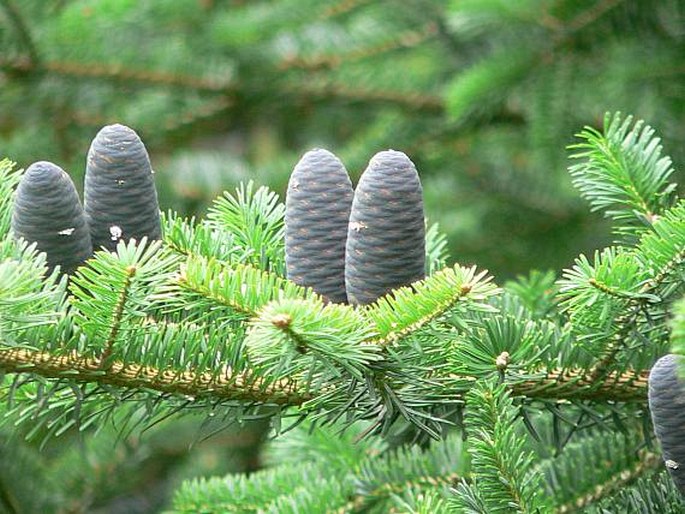Abies homolepis
Nikko Fir ( Abies homolepis )
The Nikko Fir ( Abies homolepis ) is a plant of the genus fir (Abies ) within the (Pinaceae ). It is native to Japan.
- 5.1 Notes and references
- 5.2 Additional literature
Description
Vegetative characteristics
The Nikko Fir is an evergreen tree, the plant height of 25 to 40 meters and a trunk circumference of 1-5 meters reached. It has a relatively broad and loose, pyramidal crown, which is formed by horizontally outgoing branches from the trunk. The bark is kleinschuppig and has a reddish - gray to dark purple - gray color. The color of the deeply furrowed bark of the branches ranges from gray to brown to yellowish brown with a pink twist.
Those with a size of 10 to 14 mm conical- ovoid buds are partially obscured by the needles are brown and covered with a white layer of resin. At the top of the branch needles V-shaped stand placed while they are disposed horizontally on the affiliate page. The needles are 1-3 cm long and 2 to 2.5 mm wide. The needles are colored glossy dark green and bluish - white. At the base they are twisted and the needle tip is blunt or split in two. At the needle base run six to eight Stomatabänder.
Generative features
The Nikko fir is monoecious - getrenntgeschlechtig ( monoecious ). The at a length of about 1.4 inches and a diameter of 7 mm ovoid male cones are yellowish - green. The cylindrical with a length of 7 to 10 inches and a diameter of 3-4 cm cones are resinous and maturity towards dark purple to brownish. The gray seeds are about 1.8 inches tall.
Distribution and location
The Nikko fir originates from the Japanese islands of Honshu, Kyushu and Shikoku, and settled there, especially the cool mountainous regions at altitudes 700-2200 m. Today it is used worldwide especially in temperate latitudes as an ornamental plant for parks and gardens.
In the natural habitat it forms together with other cold-adapted trees like the girls pine ( Pinus parviflora ), Japanese yew ( Taxus cuspidata ), the Japanese arborvitae (Thuja standishii ) and the northern Japanese hemlock ( Tsuga diversifolia ) mixed stands.
System
The first description of Abies homolepis in 1842 by Philipp Franz von Siebold and Joseph Gerhard Zuccarini in Flora Japonica, 2, p 17, Table 108 The Nikko fir is within the genre of fir (Abies ) in the section Momi and subsection Homolepoides provided.
A synonym for Abies homolepis sieve. & Zucc. is Abies brachyphylla Maxim ..
Threats and conservation
The Nikko fir is classified as " not at risk " in the IUCN Red List. The IUCN points out, however, the re-examination of the risk is necessary.
Swell
- Christopher J. Earle: Information about Abies homolepis at The Gymnosperm Database, 2010 (Section Description and systematics; viewed 18 December 2010 ).









